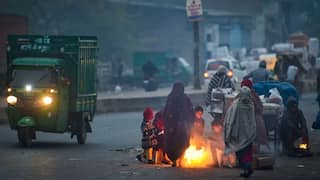Agra Lok Sabha Seat 2024: It's 'Class Politics' Vs 'Caste Politics' In The SC Constituency
Despite being an SC seat and the region having a significant Dalit population, Mayawati's Bahujan Samaj Party has never been able to score in Agra since the party's inception in 1984.

Agra, the land of the Taj Mahal and petha, is among the 80 Lok Sabha seats of Uttar Pradesh. Agra Lok Sabha constituency, which is part of the district of the same name. The first Lok Sabha election for the seat was held in 1952. The seat is currently held by former Union minister Satya Pal Singh Baghel from the BJP, which has retained the constituency since 2009 elections. Prior to that, actor-turned-politician Raj Babbar had held the seat for two terms.
Agra, situated in the northwestern part of Uttar Pradesh, the district is spread over 4,027 square kilometres. Located along the Yamuna, Agra is around 378 kilometres west of Lucknow, the state capital. It is about 206 kilometres to the south of New Delhi.
Renowned for its Mughal-era structures, including the Taj Mahal, Agra Fort, and Fatehpur Sikri — all designated UNESCO World Heritage Sites—the district is a significant tourist destination. Agra is part of the Golden Triangle tourist circuit — the other two vertices being Delhi and Jaipur — and the Uttar Pradesh Heritage Arc, a tourist circuit within the state, alongside Lucknow and Varanasi. Geographically situated in the Braj cultural region, Agra boasts a rich cultural and historical legacy.
With a population of 4,418,797, Agra district ranked 41st among 640 districts in 2011, when the last census was conducted. According to the census, it has a relatively low sex ratio of 859 females per 1,000 males. As many as 5,29,462,
The literacy rate is over 71% in the district. According to the last census, the population in Agra is predominantly Hindu with 88.77% residents, belonging to the community.
The politics of Agra, one of the most populous districts in Uttar Pradesh, sees a caste-vs-class fight.
The Ambedkar Connection
The Agra Lok Sabha seat is reserved for members of the Scheduled Caste community. The seat is of special significance for the Dalit history as Father of the Constitution of India BR Ambedkar delivered his last speech in Agra in March 1956, according to the Ambedkar International Center.
March 18 in Dalit history - Dr. B.R. Ambedkar’s speech in Agra.
— Ambedkar International Center (AIC) (@ambedkar_center) March 19, 2021
In 1956, Ambedkar made his last speech in Agra in which he expressed his anguish at educated Dalits for their self-interest, and communicated a guideline for the future.https://t.co/ni47RB3lhy#TodayInHistory
Since 2009, the seat has been a BJP stronghold, with Ram Shankar Katheria winning the constituency in 2009 and 2014, and Satyapal Singh Singh Baghel winning it in 2019. Before Katheria, Raj Babbar held the seat for two terms (1999, 2004) on Samajwadi Party ticket. The seat had been earlier held for the longest time by the Congress's Seth Achal Singh, who won five straight terms from 1952 to 1971.
Baghel won the 2019 elections with 6,46,875 votes, recording a win margin of 56.48%. He eventually went on to become the Minister of State for Health. He will contest the seat in the upcoming election as well
Surprisingly, despite being an SC seat and the region having a significant Dalit population, Mayawati's Bahujan Samaj Party has never been able to score in Agra since the party's inception in 1984. On the other hand, the BJP's apparent shift from 'caste politics' to 'class politics', with the focus on "yuva, mahila, kisaan, aur gareeb [youth, women, farmers and poor]" paid off as it has made Agra its stronghold now.
The Congress and the I.N.D.I.A bloc, meanwhile, is focussed on caste politics, with Rahul Gandhi focussing on the OBC community and Dalits during his Bharat Jodo Nyay Yatra. A significant move in this direction was seen on Sunday when Samajwadi Party chief Akhilesh Yadav joined Gandhi on his yatra in Agra and urged voters to honour Ambedkar's dreams.
Agra: Politically Important For Centuries
Taj Mahal and Mughal Era: The Taj Mahal, a UNESCO World Heritage Site, was commissioned by Mughal Emperor Shah Jahan in memory of his beloved wife Mumtaz Mahal. The Taj Mahal was declared as one of the seven new wonders of the world. The construction of this magnificent marble mausoleum began in 1631 and was completed in 1648. The Taj Mahal is the highest-grossing tourist attraction among the 144 monuments under ASI.
Agra Fort: Another significant historical structure in Agra is the Agra Fort, a UNESCO World Heritage Site that served as the main residence of the Mughal emperors until 1638. Built by Emperor Akbar between 1558 and 1573, the fort represents a blend of Islamic, Persian, and Indian architectural styles.
Mughal Capital: Agra served as the capital of the Mughal Empire during different periods, witnessing the reigns of Akbar, Jahangir, Shah Jahan, and briefly Aurangzeb. The city flourished as a centre of art, culture, and commerce during this time. It became a melting pot of diverse influences and a hub for various artistic and architectural achievements.
Colonial Era and British Influence: Agra played a role in the colonial history of India. The British established control over the region, and Agra became an important administrative and military centre during their rule. The city witnessed significant changes in infrastructure and governance.
Post-Independence Development: After India gained independence in 1947, Agra continued to develop as a major city in Uttar Pradesh. It became an important tourist destination, not only for the Taj Mahal but also for its historical and cultural heritage.
Related Video
Navi Mumbai Civic Polls: Shiv Sena and BJP to Contest Separately, No Alliance Announced


































